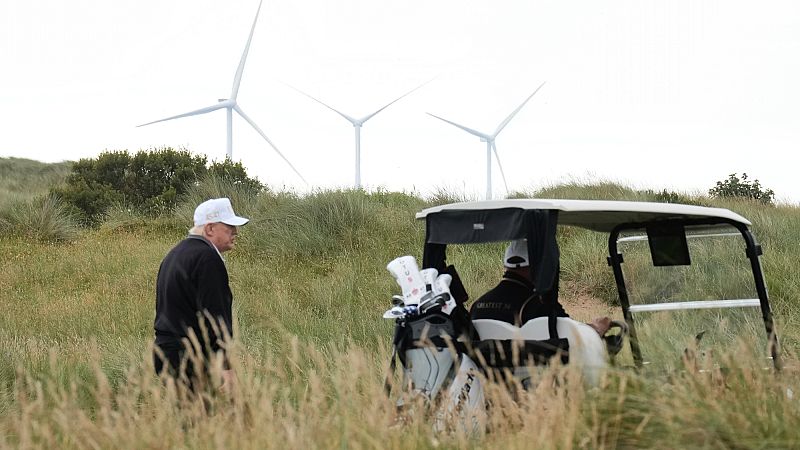
During a visit to Scotland this week, Donald Trump urged Europe to “stop the windmills”, branding wind energy as ineffective and harmful.
Speaking to reporters at Prestwick Airport upon arriving in the country last Friday, he said, “You see these windmills all over the place, ruining your beautiful fields and valleys and killing your birds, and if they’re stuck in the ocean, ruining your oceans.”
The US President then launched into a tirade about wind energy during a press conference on Sunday with European Commission President Ursula von der Leyen to announce a new trade deal, calling it a “con job” that “doesn’t work”. Speaking at his Turnberry golf resort, he said wind turbines in Aberdeen were “some of the ugliest windmills you’ve ever seen”.
On Monday, during a press conference with UK Prime Minister Keir Starmer, Trump again attacked wind energy, calling turbines “ugly monsters” and urging Starmer to instead back North Sea oil and gas.
Trump’s opposition is nothing new, and his war on wind energy began during a long-running battle with Scottish authorities over 11 wind turbines that can be seen from his Turnberry luxury golf resort. The legal challenge, launched in 2013, was ultimately dismissed by the UK Supreme Court in December 2015.
His recent comments on wind energy add to a litany of complaints from the well-known climate change denier over the years, but how accurate are his claims about turbines?
Are wind turbines the ‘most expensive form of energy’?
“It is the worst form of energy, the most expensive form of energy, but windmills should not be allowed,” Trump claimed.
A recent report on the costs of renewable energy from the International Renewable Energy Agency (IRENA) found that, globally, wind power is now 53 per cent cheaper than the lowest-cost fossil fuel alternative. Onshore wind was found to be the most affordable source of new power generation.
As technology has advanced, supply chains have become more competitive and manufacturing has scaled up, the report explains, leading to a drop in prices. Onshore wind costs in particular have plummeted by 56 per cent since 2010.
Trump may have been referring to the UK government increasing the maximum price it is prepared to guarantee companies generating electricity from new wind farms.
Each year, companies that want to build renewable energy projects bid for government-backed contracts. Energy Secretary Ed Miliband has faced criticism for setting the maximum price for offshore wind at £113 (€130) per megawatt-hour (MWh) of energy - up from £102 (€118) in 2024 - at an upcoming auction of these contracts which opens in August.
Currently, the wholesale gas price is £78 (€90) per MWh, but this frequently fluctuates, reaching over £170 (€196) per MWh during the 2022 price spike.
The UK government has said that these prices don’t represent a final amount, however, as companies will put in lower bids to win the auction. It claims that this auction will reveal the true price, referring back to last year, where prices cleared significantly lower than the maximum it set.
Do wind turbines ‘rust and rot’ in eight years?
Trump claimed that wind turbines “start to rust and rot in eight years” and, when they do, “you can’t really turn them off, you can’t burn them. They won’t let you bury the propellers, the props, because there’s a certain type of fibre that doesn’t go well with the land.”
IRENA cites the average lifespan of a wind turbine as around 20 and 25 years, not eight. Manufacturers say that some modern wind turbines in well-maintained locations can operate for 30 years or more.
Scottish Power, for example, launched a repowering initiative in 2023 for Scotland’s oldest onshore wind farm, which has been producing energy since 1998.
Scientists from the EU’s Joint Research Centre estimate that by 2050, the annual waste from wind turbines could be around 10 million tonnes. But around 80 to 95 per cent of their mass, including materials like steel, concrete and copper, can be recycled, according to industry groups like WindEurope.
Recycling the propellers, or turbine blades, can be a bit trickier. Designed to be lightweight and durable, they are often made from fibreglass or carbon fibre held together with resin. This can be hard to separate, making recycling particularly difficult and expensive.
Companies are working on solutions to the problem, however. In 2021, the European wind industry committed to reusing, recovering, or recycling 100 per cent of decommissioned blades and has called for a ban on sending them to landfills.
Recycling technologies have significantly advanced since then, with new methods to break down this waste into usable components for products like cement additives. New blade designs are also incorporating more recyclable materials to make this process easier in the future.
Reusing or upcycling blades is another alternative, with companies like Sweden’s Vattenfall using them as part of a parking garage and Ireland’s BladeBridge turning them into pedestrian bridges.
Are ‘almost all’ wind turbines made in China?
The US President claimed that “they’re made in China, almost all of them” and he isn’t entirely wrong.
China is currently the world’s biggest manufacturer of wind turbines and their components. Around 60 per cent of global wind turbine production capacity is estimated to be in China, according to the Global Wind Energy Council.
There are also significant manufacturing hubs elsewhere in the world with key producers in Germany, Spain, France and Denmark. Europe is thought to make up around 19 per cent of global manufacturing.
As of 2024, around 90 per cent of commissioned wind projects in Europe used European-made wind turbines, according to a report from WindEurope.
But with soaring demand for renewables, an ambitious EU clean energy target and much lower costs from Chinese manufacturers, countries are increasingly looking outside of Europe for their turbines.
Are wind turbines ‘killing birds’?
Trump also claimed that wind turbines are harming wildlife, including whales and birds.
He said they are driving whales “loco” and killing them. Though a lot of whale behaviour is complex and not yet particularly well understood by scientists, the US National Oceanic and Atmospheric Administration says there is no evidence linking offshore wind turbines to whale deaths.
Some activists have in the past suggested that building new wind farms, which involves techniques like surveying using acoustic waves, could impact whales. There is little evidence to suggest fatal impacts, however, and many countries have regulations in place to protect marine creatures during surveying for wind farm construction.
Human interactions, such as ship strikes or entanglement in fishing gear, are much more likely to cause fatalities.
Trump also said that wind farms “kill the birds”. Wind turbines do cause bird fatalities, but only a fraction of the number killed by threats like cats, power lines, buildings or even climate change itself. Their impact can also vary depending on the time of year, place or local species of bird, with some wind farms killing large numbers of birds and others killing none.
It is still a threat that needs to be taken seriously, and scientists are working on ways to avoid birds colliding with the turbines. Simple solutions being explored involve painting turbine blades in contrasting colours or patterns to make them more visible. More complex options could see AI tech used to shut down turbines when birds approach.
Experts say location is probably the most important factor in determining how dangerous a wind farm could be to birds. Studying sites to determine their impact before building could dramatically reduce their impact.
Did wind energy fail in Germany?
“The whole thing is a con job,” Trump said, adding that “Germany tried it, and wind doesn’t work.”
Last year, wind power accounted for 28 per cent of Germany’s electricity generation, making it the country’s largest single source of electricity.
Overall, renewable sources, including wind, solar, biomass and hydroelectric, made up nearly 60 per cent of its energy mix. During the first nine months of 2024, wind and solar generated more electricity than fossil fuels for the first time ever.
The increase in renewables’ share was driven by growth in wind and solar power. Wind alone was responsible for 31 per cent of the increase in Germany’s renewable generation, according to think tank Ember.







